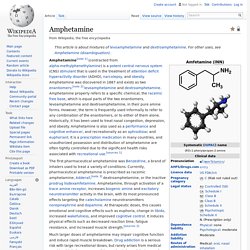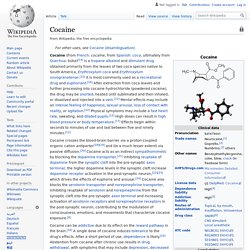

Methamphetamine. Methamphetamine[note 1] (pronunciation: /ˌmɛθæmˈfɛtəmiːn/; contracted from N-methyl-alpha-methylphenethylamine) is a neurotoxin and potent psychostimulant of the phenethylamine and amphetamine classes that is used to treat attention deficit hyperactivity disorder (ADHD) and obesity. Methamphetamine exists as two enantiomers, dextrorotary and levorotary. [note 2] Dextromethamphetamine is a stronger central nervous system (CNS) stimulant than levomethamphetamine; however, both are addictive and produce the same toxicity symptoms at high doses. Although rarely prescribed due to the potential risks, methamphetamine hydrochloride is approved by the United States Food and Drug Administration (USFDA) under the trade name Desoxyn. Recreationally, methamphetamine is used to increase sexual desire, lift the mood, and increase energy, allowing some users to engage in sexual activity continuously for several days straight.
Uses. Amphetamine. The first pharmaceutical amphetamine was Benzedrine, a brand of inhalers used to treat a variety of conditions.

Currently, pharmaceutical amphetamine is prescribed as racemic amphetamine, Adderall,[note 3] dextroamphetamine, or the inactive prodrug lisdexamfetamine. Amphetamine, through activation of a trace amine receptor, increases biogenic amine and excitatory neurotransmitter activity in the brain, with its most pronounced effects targeting the catecholamine neurotransmitters norepinephrine and dopamine. At therapeutic doses, this causes emotional and cognitive effects such as euphoria, change in libido, increased wakefulness, and improved cognitive control. Cocaine. Cocaine is addictive due to its effect on the reward pathway in the brain.

After a short period of use, there is a high risk that dependence will occur.[9] Its use also increases the risk of stroke, myocardial infarction, lung problems in those who smoke it, blood infections, and sudden cardiac death.[9][12] Cocaine sold on the street is commonly mixed with local anesthetics, cornstarch, quinine, or sugar which can result in additional toxicity.[13] Following repeated doses a person may have decreased ability to feel pleasure and be very physicially tired.[9] Cocaine acts by inhibiting the reuptake of serotonin, norepinephrine, and dopamine. After cannabis, cocaine is the most frequently used illegal drug globally.[17] Between 14 and 21 million people use the drug each year.